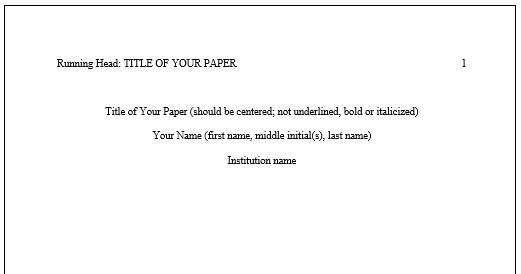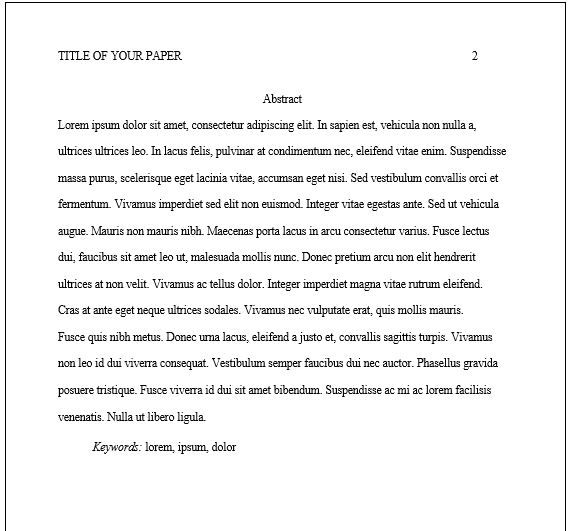Research Paper Basics: APA Style
Research Guide: APA Format
According to the American Psychological Association, APA Style “originated in 1929, when a group of psychologists, anthropologists, and business managers convened and sought to establish a simple set of procedures, or style rules, that would codify the many components of scientific writing to increase the ease of reading comprehension.” Similar to other writing styles, APA style concerns itself with elements including but not limited to:
- selection of headings, tone and length
- punctuation and abbreviations
- presentation of numbers and statistics
- construction of tables and figures
- citation of references
APA style is most often used by writers in the behavioral and social science fields such as psychology, sociology and social work. Examples of papers that might use APA style format are empirical studies, literature reviews, theoretical articles, methodological articles and case studies.
Where Do I Start?
The American Psychological Association has established this style to help writers achieve minimum distraction and maximum precision through the use of established style rules and guidelines. The APA publishes the Publication Manual of the American Psychological Association which offers advice on choosing headings, tables figures and tone to help aid in the construction of your paper. The manual is currently in its 6th edition. Some branches of The Library have copies of this handbook in their reference collection, meaning you can only use it when you are in that library. Others will have copies available for checkout. Just ask a librarian to help you locate it.
Some basic elements of a paper written in APA style would include:
- Typed on a computer and printed out on standard, white 8.5 x 11-inch paper.
- Should be double-spaced with 1" margins on all sides.
- Written in a clear font that is highly readable (APA recommends using 12 pt. Times New Roman font)
- Page header (also known as a “running head”) at the top right-hand corner of every page of the paper; the running head will be a shortened version of your paper’s title limited to 50 characters including spacing and punctuation `
- A title page including the paper’s title, author’s name and institutional affiliation
- An abstract, written on its own page, which will function as a summary of the key points of your research
All public computers at The Library have Microsoft Word. A reference librarian or computer assistant can help you adjust the settings for fonts, margins, indents, and more.
What are the parts of an APA Style Research Paper?
Title Page
APA papers require title pages. Your title page will first include your running head (the title of your paper) along with the proper title of the paper, your name, and your school or professional affiliation and will be double-spaced. Your running head will appear flush left at the top of the page as follows:
Running head: TITLE OF YOUR PAPER (capital letters)
Page number 1 will be flush right of the running head.
(Note: Your title page is the only page that will include the words “running head” before the title.)
Then type your complete title in uppercase and lowercase letters (APA recommends no more than 12 words in length). Your title is allowed to take up more than one line. Beneath the title, type your name as follows: first name, middle initial(s), last name. Beneath the author’s name, type the institutional affiliation, will most likely be where your research was conducted (school).
Abstract
Begin a new page. Your abstract page should already have your running header flush left at the top and page number “2” at the top flush right. On the first line of this new page, center the word “Abstract” (no bold, underline or italics). On the next line (do not indent), write a brief summary of the key points of your paper. You might include your research methods, questions, participants, results, data analysis and conclusions. The abstract should be a 150-250 word double-spaced single paragraph.
You can also include a keywords list beneath your abstract. Beneath your summary, indent once and type “Keywords:” (in italics) and then list keywords from your paper separated by commas.
Main Body
The body of your paper should maintain the 12 pt. readable font, doubled-spaced, with the running head and page number at the top of each page. First person point of view is allowed when discussing your research steps and methods (“I calculated…”). Active voice is preferred over passive (“We interpreted the results” vs. “The results were interpreted”). Be specific in your descriptions and explanations. Go heavy but remain accurate on details of your findings. Avoid bias in your word choices and avoid poetic and figurative language. Instead, use simple adjectives and plain language so that your reader won’t mistake your meaning.
Citations
In APA style, your list of citations is called your “References.” Your reference list will appear at the end of your paper on its own page(s). It allows your readers to locate any source you cite in the body of your paper. Label your list “References” at the top of your list, centered (do not bold, underline or italicize). Your reference page will be double-spaced just like the rest of the paper. More specifics on how to format your References page will follow.
How Do I Cite My Sources?: Your References and In-Text Citations
APA Style requires you to cite the sources of your paper in two ways: by maintaining a References page and by including in-text citations.
References Page
The References page appears at the end of your paper. It is a list of every source you used or consulted within the body of your paper. The References page allows your readers to locate and retrieve exactly where you found your information if need be.
APA citation style has some basic form guidelines. For example, authors are listed alphabetically by last name, followed by their initials. Publication year goes between parentheses, followed by a period. For the title of the article, only the first word and proper nouns in the title are capitalized. The periodical title has normal capitalization followed by the volume number which is italicized along with the title. Then list page numbers of the article you reference in your paper. If you accessed an article online, a URL link is needed in the citation.
Here is a sample article citation:
Harlow, H. F. (1983). Fundamentals for preparing psychology journal
articles. Journal of Comparative and Physiological Psychology,
55, 893-896.
The exact information included in each citation as well as the format might vary depending on what source material you are citing, whether it be an article in a magazine, newspaper, journal, book or electronic source. The Publication Manual of the American Psychological Association explains these differences and specifics in Chapter 6: Crediting Sources.
In-Text Citations
In-text citations are words and numbers enclosed in parentheses throughout your paper after you quote or paraphrase someone else’s idea. The idea is to give credit where credit is due and to avoid plagiarism. APA style uses the “author-date” method of in-text citation. This means that the author’s last name and the year of publication for the source you are citing should appear in the body of your paper, for example, like this: (Smith, 2009), and a complete reference should appear on your References list at the end of the paper.
Here are some further in-text citation tips:
- Always capitalize proper nouns including initials in author’s names
- Italicize or underline the titles of longer works such as books, collections, movies, television series, documentaries or albums (IE: The Wizard of Oz or The Wizard of Oz)
- Use quotation marks around titles of shorter works such as journal articles, television series episodes and song titles
Additional Help
There are several sources online that can help with issues that might arise when working with APA style formatting.
These websites are maintained by universities and are pretty reliable, however it is important to double check that you have the proper format by cross-referencing your citations with the Publication Manual of the American Psychological Association.
Find this article at

